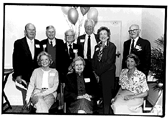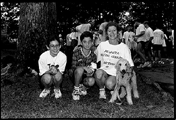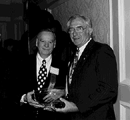Becoming a part of the Emory community
A Message from the Executive Director of the Association of Emory Alumni
By Bob Carpenter
When did you become a member of the Emory community?
I ask this question not in the practical sense of what year you enrolled, or the date you received your letter of acceptance, but more in a philosophic sense. When did you feel embraced by the people, places, and traditions of the institution? When did you embrace Emory? When did you feel you had become part of the flock, a member of the assemblage, a dweller in the community?
What was it that made you feel that bond? Was it a night in Dooley's Den or the Dugout, talking to friends on the steps of Candler Library, or going to Everybody's with your favorite professor? Was it a championship season, a Dooley's skit on Fraternity Row, or a trip with the Glee Club/Chorale/Chorus? Was it your study group in graduate school or a walk on the Quad at Oxford?
Or did you ever take that step? Was there ever a point in your Emory experience when you felt that link to the greater group that would last a lifetime? Or did the University miss out on its opportunity to instill in you this sense of belonging while you were here? If so, how can we--alumni, students, and administrators--make sure we do a better job of it in the future?
These are some of the questions that were considered by the Board of Governors of the Association of Emory Alumni during the past year. They grew out of a conversation begun last fall at the Alumni Strategic Planning Conference and continued during Assembly XVI, "The Soul of the Academy." After much intense discussion, this issue of community building on our campuses--and the perceived lack thereof--emerged as the most often cited concern among the participants. Without the galvanizing effect of a Division I sports program, how do we grow our "center" and introduce and initiate members to our tribe? What are our rituals? Do we have times and spaces that are "sacred" and part of our collective lore?
In response to these questions and concerns, the Board of Governors will consult with alumni and other interested groups to dig vigorously into these issues and to make recommendations for our future. We hope to have a report to present to you by the end of this academic year.
This is one example of the strong work being done by the Board of Governors. Charged with oversight of all alumni programming at the University, the board also selects the recipients of the Emory Medal and makes nominations for the alumni trustee members of the University Board of Trustees. Under the Board of Governors' direction, we began two new programs of great significance in the past year: the development of the Alumni Career Network with a full-time director and the inaugural program of College Admission 101, a seminar for alumni and their high-school-aged children on the process and potential pitfalls of applying to a selective university or college.
Our Board of Governors is a working group, one that continues to expand its role in the life of alumni and the life of the current University. If you have recommendations to make to the board, particularly regarding the community building report, I would be glad to pass them on. You can contact me at 404-727-6400, by e-mail at rcarpen@emory.edu, or by mail at the Association of Emory Alumni, Emory University, Atlanta, GA 30322.
Bob Carpenter
Executive Director
Association of Emory Alumni
Back to school
Emory graduates reunite on campus
Some two thousand alumni, their families, and friends of the University gathered on campus this fall for Alumni Weekend activities. Events included the dedication of the Goizueta Business School's new facility, the Alumni 5K Fun Run, the presentation of this year's Emory Medals, the Sports Hall of Fame induction banquet, and reunions for Emory College, the Candler School of Theology, undergraduate business, and the schools of medicine, nursing, and public health. Attendees also had a chance to take a walking tour of the Quadrangle with Dean of Alumni Judson C. Ward '33C-'36G, hear renowned blues guitarist Tinsley Ellis '77Ox-'79C play on McDonough Field for the young alumni band party, and see photographs of contemporary Kenya at the Michael C. Carlos Museum. Below are scenes from this year's Alumni Weekend activities.
In the next forty years, the white population in this country is expected to go from 191 million to 202 million, which is considered no growth. The black population will double. The Hispanic population will quadruple. The Asian population will increase fivefold. This is a wonderful, fabulous blessing, one that this country has embraced as the American experienceall of its history. Our challenge, as it's always been, is how to deal with it. We do it messily, we do it slowly, we sometimes do it hatefully, we do it with great effort. But the reason I believe we really are able to meet it is we do have something that unifies us, and it's the Constitution. Without it we really have absolutely no reason to exist in this country. We have no shared history, we have no shared ethnicity, we have no shared religion. But what we do have is that document. And the institutions created by this Constitution allow us to celebrate this diversity on a common ground, century after century.
--Cokie Roberts, ABC News correspondent, speaking at the Emory Medal ceremony
Photo by Annemarie Poyo
Emory Sports Hall of Fame inducts its Class of 1997
During Alumni Weekend, the Emory Sports Hall of Fame inducted its Class of 1997. In attendance were (clockwise from top left) three-time tennis All-American Gavin Patrick O'Connell '91C, who went on to play professional tennis for the Atlanta Thunder; Emory varsity swimmer John Payson Kennedy '54C-'59G, co-founder of the Nantahala Outdoor Center and a multiple national open canoe champion; William C. Cromwell '56C, who lettered in and co-captained both the wrestling and track teams and won the Herbert Levine Memorial Award for Outstanding Sportsmanship in 1956; six-time All-American and three-time national champion diver Christopher Jon Radpour '90B; Thomas A. Rowles '74C, a soccer standout at Emory who captained the team his senior year and went on to complete various marathons and play in the national over-thirty soccer championships for the elite Atlanta-based Datagraphic club; Elizabethe Segars McRae '90C, Emory's first women's soccer All-American and the assistant women's soccer coach in 1995; and John M. Morgan '42C-'45M, who was All-Emory in football from 1939 to 1942 and was ranked in the top ten in seniors tennis in Florida from 1976 to 1993. Four members were inducted posthumously: Vaughn Nixon 1900C, a champion sprinter and an outstanding athlete in basketball, football, and baseball; Emmett K. Perryman '13C, who was on the All-Emory baseball team and went on to pitch for one year with St. Louis of the American League; Henry Lumpkin Bowden '32C-'34L-'59H, who was selected to the All-Emory basketball team three times, was a sportswriter for the Emory Wheel, and was an advocate for Emory athletics during his twenty-six years as chairman of the Board of Trustees; and David Grier Martin '33G, who earned varsity letters in basketball and track, was Southeastern AAU hurdles champion, and was president of Davidson College from 1958 to 1968.
Photo by Annemarie Poyo
Arts and Sciences Distinguished Alumni Awards
During a reception and dinner in the Dobbs University Center, Steven E. Sanderson (top right), vice president for Arts and Sciences and dean of Emory College, and Donald G. Stein (top left), vice provost and dean of the Graduate School of Arts and Sciences, presented this year's Arts and Sciences Distinguished Alumni Awards. The three alumni honored with these lifetime achievement awards were (bottom row from left) Harold S. Johnston '41C, one of the first scholars to offer evidence of damage to the ozone layer from aircraft, who recently received the Medal of Science Award at a White House ceremony; M. Kathleen McCulloch '74G-'77G, a member of the Emory Alumni Board of Governors since 1992, who has devoted her career to service in the federal government and is currently resource manager in the Defense Information Systems Agency; and heart surgeon H. David Short III '70C, who established the Sonny Carter Scholarship at Emory in honor of his late friend, astronaut Manley Lanier "Sonny" Carter Jr. '69C-'73M.
Distinguished dental alumnni
Lawson K. Broadrick '54D (left) was honored with the 1997 Distinguished Alumnus Award, and Peter A. Jensen Jr. '56D was honored with the 1997 Meritorious Service Award by the Emory Dental Alumni Association. According to the group's president, John F. MacNamara '78D, the award winners have "an expertise that has set a standard for dentists across the Southeast." Broadrick, who has had a private practice in general dentistry in Atlanta since 1962, has served as president of both the Georgia Academy of Dental Practice and the Emory Dental Alumni Association. In 1975, he introduced the prepless bridge, a technique for replacing a missing tooth. A charter member of the Georgia Academy of Dental Practice, Jensen has also been actively involved in numerous other professional organizations, including the American College of Dentists and the International College of Dentists. He has had a private practice in general dentistry in the Emory and Northlake areas for forty years.
Photo courtesy Foster and Associates
A businessman and civic leader of vision, Ben J. Tarbutton Jr. '49Ox-'51C helped shape the industrial history of central Georgia. He is co-owner of the Sandersville Railroad and shares his expertise with a variety of firms and public agencies. He is the director and past president of the Georgia Chamber of Commerce and a member of the board of both the Georgia Department of Industry, Trade, and Tourism and the Department of Natural Resources. Tarbutton is a former member of the Emory Board of Visitors and the Board of Counselors of Oxford College and has served on the Emory Board of Trustees since 1976.
Photo by Kay Hinton
A dedicated builder of the community, Nancy Rankin Tarbutton '57C has worked tirelessly to promote and support her city, state, Emory University, and the United Methodist Church. She has served as a member of the Washington County Library Board, trustee of the Georgia Trust for Historic Preservation, and president and trustee of the Transylvania Club, an organization that supports the community's libraries. She has also served on the boards of the Atlanta College of Art and the State Botanical Garden of Georgia. In her long service to Emory, Tarbutton has worked to promote the Candler School of Theology's Committee of One Hundred, particularly with regard to the Etheredge Trust, which supports a number of Candler students each year.
Photo by Kay Hinton
In 1991, H. Jackson Brown Jr. '63C published Life's Little Instruction Book, a volume of heartfelt observations and words of counsel he had originally written to give to his son as he went away to college. The book became an international bestseller, and Brown went on to publish a number of other popular works, including A Father's Book of Wisdom and The Little Book of Christmas Joys. His books have sold more than twenty-one million copies and have been translated into thirty-one languages. Brown served Emory as the honorary national chair of the 1994-1995 Emory/Coca-Cola Challenge Fund and has been a board member of the American Cancer Society.
Photo by Kay Hinton
The commitment of ground-breaking jurist Glenda A. Hatchett '77L to the nation's children has made her a leader in changing the juvenile justice system. Appointed to the position of chief presiding judge of Fulton County juvenile court in 1991, she is Georgia's first African-American chief presiding judge of a state court as well as the department head of one of the largest juvenile court systems in the nation. Her innovative introduction of public and private partnership initiatives has revolutionized the way troubled children are treated in Atlanta and across America. Hatchett is a member of the Children's Defense Fund, the advisory board of the Morehouse School of Medicine's Center for Child Abuse and Neglect, and the faculty of the National Judicial College of the National Council of Juvenile and Family Court Judges.
Photo by Kay Hinton
As an esteemed professor and dean, Ben F. Johnson Jr. '36C-'40L guided Emory Law School through a tumultuous and remarkable time. With the late Henry Bowden Sr. '32C-'34L, Johnson, who was dean of the law school from 1961 to 1973, personally briefed and argued the landmark case that integrated Georgia's private universities. Throughout his career he remained a strong and effective advocate for women and minorities. During his tenure at Emory Law School, Johnson also served as Georgia's deputy assistant attorney general and was elected a senator in the Georgia legislature. In 1989, Johnson received the Emory Law School Distinguished Alumnus Award.
Photo by Annemarie Poyo
Anne Elizabeth Hendrick Gaston '55M, the first woman to be president of an Emory medical school class, has devoted her professional life to improving health care for children. For twenty-three years she practiced as a neonatologist and pediatrician in northern California before moving back to Atlanta. Now retired, she continues to counsel and instruct through Healthcare Partnership Consultants. Gaston was a founding member and president of the Association of Emory Alumni (AEA) Board of Governors, president of the AEA, and a member of the University's Board of Trustees. She currently serves as co-chair of the National Council of Medicine at Emory and with her husband, J. Harper Gaston IV '52C-'55M, has established the Gaston Service Scholarship, awarded to Emory medical school students who demonstrate outstanding volunteer and community service.
Photo by Ann Borden
J. Harper Gaston IV '52C-'55M has been on the leading edge of change in the delivery of medical services throughout his career. Now retired, he continues to provide leadership to the medical community as both CEO and president of Gaston Loughlin Inc. and Healthcare Partnership Consultants. Gaston is co-chair of the National Council of Medicine at Emory and with his wife, Anne Elizabeth Hendrick Gaston '55M, has established the Gaston Service Scholarship, awarded to Emory medical school students who demonstrate outstanding volunteer and community service. He has also been active with the Emory University System of Healthcare Board of Directors, the Woodruff Health Sciences Center Campaign Committee, and the Emory University Board of Visitors.
Photo by Annemarie Poyo
With a career spanning more than forty-five years, Edith Folsom Honeycutt '39N is to many the embodiment of excellence in nursing practice and education. According to a former dean of the Nell Hodgson Woodruff School of Nursing, Honeycutt "epitomizes the very best of what nursing can and should be." An energetic and enthusiastic alumna, she served several terms as president of the Emory Nurses' Alumni Association and in 1980 received their Award of Honor. During her time as a staff nurse at Emory University Hospital, she earned a reputation for her expertise in the care of the critically ill. In 1990, the Metropolitan Atlanta Community Foundation endoweda chair in her name. No other staff nurse in the United States has a funded chair at a major university.
Photo by Ann Borden
Linton C. Hopkins '73NURL
Links to the past
Golf legend Robert Tyre "Bobby" Jones '29L, the only person to win all four Grand Slam golf titles in one season, affectionately called Atlanta's East Lake Golf Club "my golf course." Professor of Neurology Linton C. Hopkins '73NURL celebrates and chronicles that bond in his recent book, Where Bobby Learned To Play.
"No golf course can claim the soul of Bobby Jones to the same extent as East Lake," Hopkins writes. "It saw the start of his golfing life at age six and his last round at forty-six. In between he walked the course with his father and friends during his childhood, his competitive career, and for sixteen years after he retired. For forty-one years, East Lake was the course he played more than any other. He was world famous for twenty-five of those years and could have played anywhere, but day after day he came back home to East Lake to be with his father and friends."
Hopkins' book also traces the history of East Lake, which was constructed in 1908 and recently underwent an extensive renovation, restoring it to its former glory. Emory Trustee Tom Cousins played a major role in the project. In the book, Hopkins shares stories of other golf notables--many of whom were Jones' friends--who played the course, including 1938 British Amateur champion Charlie Yates.--A.O.A.
Return to Winter 1998 contents page


